Chokchai Steak House/Full Frame Advantage

|
Feature Photograph

Captured near Khao Yai National Forest. This image is significant for several reasons. The first is the most important and it’s all about timing. We were traveling down the highway at about 100 km/h after a long day of shooting in the national park and both of us were looking forward to the Chokchai Steakhouse and a nice quiet dinner. Looking over to my left I saw the sun sitting over the mountains lighting up the field. Normally I don’t stop alongside a road or highway because there will be fences and power lines interfering with anything resembling a decent image.
This time however, the scene was such that I decided to stop. The decision was immediate. The cameras were in the back, proper lens already mounted, and from the time I decided to stop until the time I was standing there outside the vehicle taking the picture was perhaps less than two minutes.
In those two minutes the sun went from being comfortably over the mountains, to being almost hidden and just peeking over. In two minutes the light had changed from the field being totally illuminated, to being what you see here. In two minutes the colors totally changed. Last week in the Feature Photograph section I gave you an example of being two minutes too late. Once again, I was two minutes late to catch the sun where I wanted, but the timing was perfect to capture the unexpected.
The unexpected sometimes results in the most memorable of captures. And sometimes (like below) the unexpected results in captures you’d rather forget.

ChokChai Steak House
An outing to a steakhouse. Where’s the adventure in that? I decided to run these images and the narrative for two reasons. The first being the food is very good and worthy of mention. The second is that we all visit places we’d like to photograph armed only with a simple point and shoot camera (in this case a Canon G9).
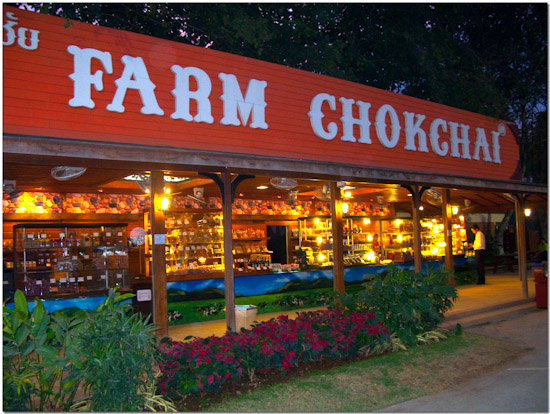
The food is indeed excellent! Chokchai farms is a huge ranch / farm located near the Khao Yai National Forest. They’ve been there a long time and it’s a complete operation. In addition to their farms and ranch they have a cowboy camp, steak house, and other vendor areas to sell their products.
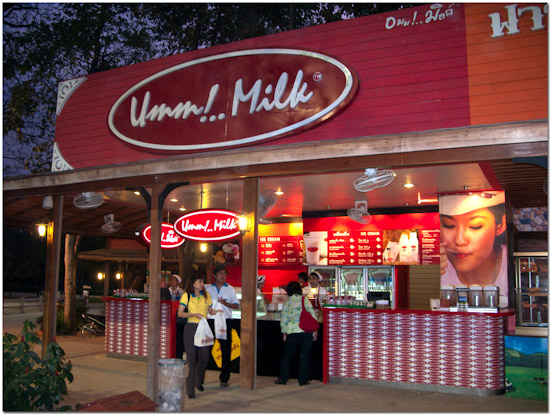
Walking in from outside you’ll see a big sign and a host ready to welcome you.
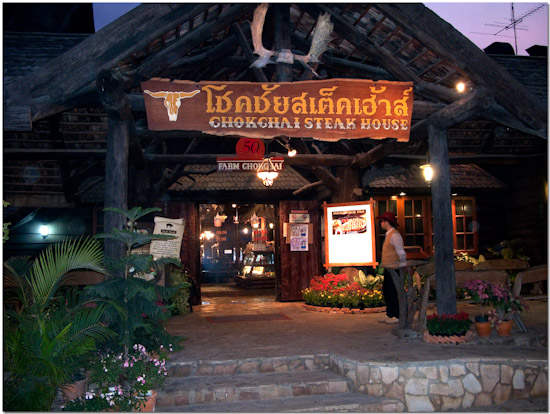
The restaurant is comfortable and decorated in a rustic fashion or rather a cowboy motif. Tables are spaced far enough apart for privacy and the noise level is low. This is clearly a place to come relax and enjoy some decent food.
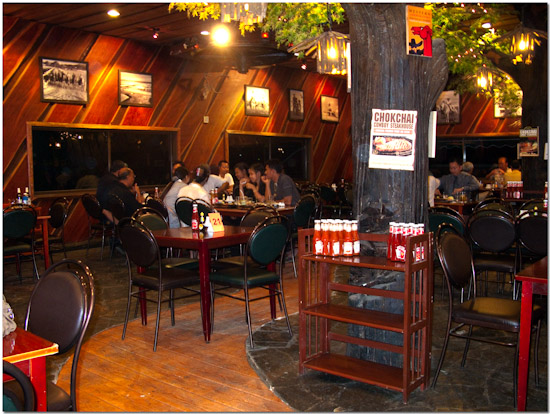
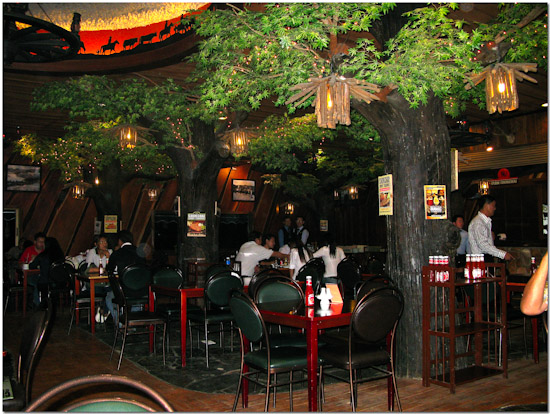
There are plenty of western decorations and the food is very good. The beef is raised right on the property and dry aged for the best taste. We had a t-bone and a rib-eye and both were about 1 inch thick, very tasty, and of a quality not often seen in Thailand. They steaks were brought to us on cast iron plates secured in wood frames with the steaks still sizzling and cooking. They were too hot to eat so we had to wait about five minutes before taking the first bite. It was well worth the wait!
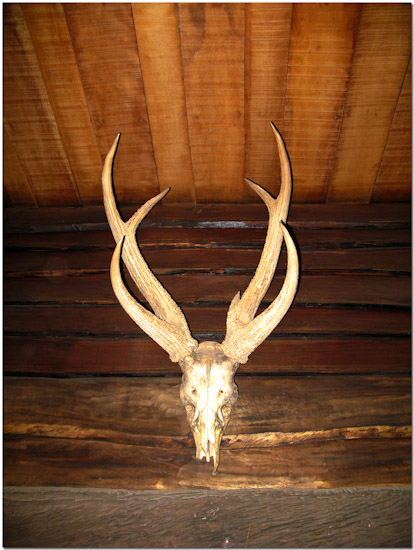
On our way out we stopped and looked at the kiosks where they sell everything from wine (from a local winery) to jams and all sorts of tasty snacks.
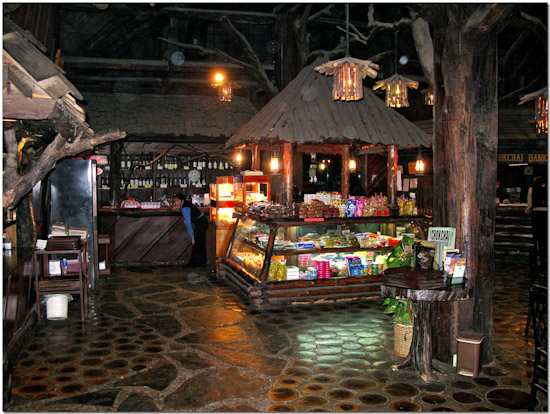
There was also a separate dining room that appeared to honor Ronald Reagan.
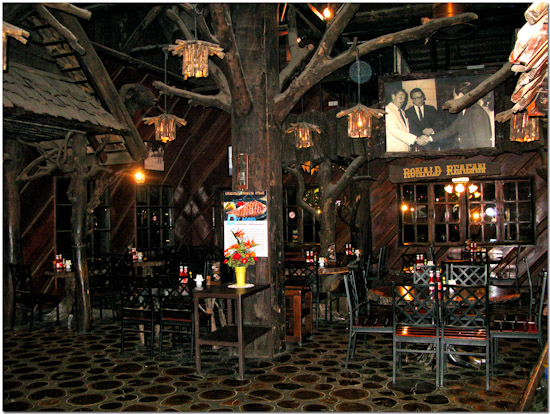
There was a Chokchai Bank open for business.
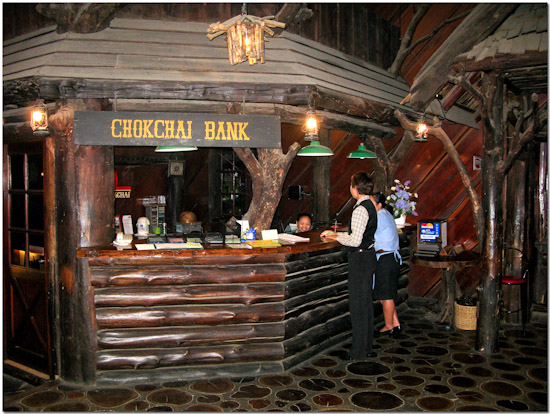
All of these images were captured with a standard point and shoot compact in Auto mode. Auto exposure, Auto focus, Auto ISO, I didn’t do anything but point and shoot and make sure I held the camera as steadily as possible. I did adjust the levels a bit in Photoshop because I was posting them in this column, but I wouldn’t have bothered for personal use.
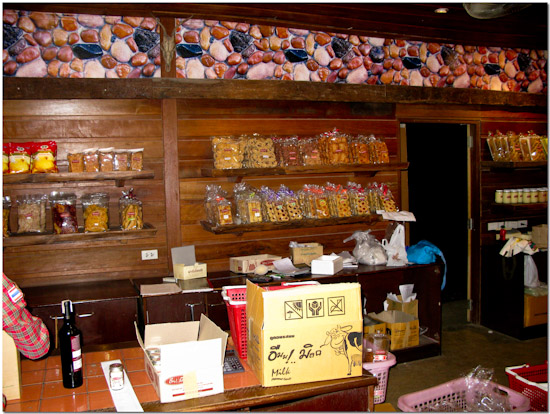
This was a very enjoyable meal. Since, I’ve heard there are other ChokChai Steak House outlets in and around Bangkok and I intend to try them out soon and see if they’re the same great quality. I didn’t mention above, but the 500 gram T-bone was 420 baht (with potato and veggies) and the 350 gram rib-eye was 380 baht. Not bad!
Full Frame Advantage
Stick has had a few months now to get used to his new Canon 5d Mark II and biggest difference from his old 20d is the inclusion of a full frame sensor. People ask me to recommend DSLRs all the time and almost without exception I’m thinking to myself “if they only knew the advantages they’d get with a full frame DSLR.” But when you ask them about their budget and realize a full frame model isn’t a possibility then you go ahead and recommend the best crop frame model (for their needs) knowing that if they ever progress to the intermediate stage they’ll eventually end up with a full frame DSLR anyway. This week Stick is going to share with us his thoughts and experiences after moving to a full frame DSLR.
I raised more than a few eyebrows when I told friends I had picked up a Canon 5D mark II and everyone wanted to know why! After all, my 20D had served me faithfully for more than 4 years. People liked the photos I took with it so why did I need to upgrade?
The answer was simple. Full-frame!
The 5D II is a full frame SLR.
What is meant when we hear the term "full frame"? It means that the size of the sensor is the same size as 35 mm film i.e. 36 x 24 mm, give or take a fraction of a millimetre.
So why is this important? Well, put simply, that is a huge sensor! The sensor is the part of the camera that captures the light that has been guided through by the lens. The theory is that the bigger the sensor, the better. So when we talk about medium format cameras the sensor is bigger again and when we talk about large format, we're talking a massive sensor and serious bragging rights! But that is the domain of professionals only so let's come back down to earth…
So how much bigger is the sensor in the 5D II than the 20D or other "compact" digital cameras like say Canon's acclaimed G10? Well, in my 20D and in all of the Canon "crop cameras", the sensor size is 22.5 x 15 mm. In a Canon G10, it is 7.6 x 5.7 mm.
Let's do the maths. The sensor in the 5D II is 36 x 24 mm meaning a total area of 864 square mm. In a crop camera it is 338 mm. That means that the full frame sensor has a far greater area to collect all the light and which, as I will try and show, results in better images. In the Canon G10, the total size of the sensor is a mere 43 square mm! Tiny! So when we talk about full-frame, these numbers start to give you some idea of just how dramatic the difference in sensor size is.
The advantages of full-frame are numerous. The sensor is the "full" size so uses all of the lens. This means that the focal length of the lens is what you actually get with it on a full-frame camera. My 24 – 70 had an effective focal length on my 20D of 38 – 112, meaning it was not very wide at all. The sensor only caught what went through the middle of the lens and the rest of the glass of the lens was essentially not used. This means that your lenses operate how they should and wide lenses really are wide, you can see in this photo of Soi Cowboy.
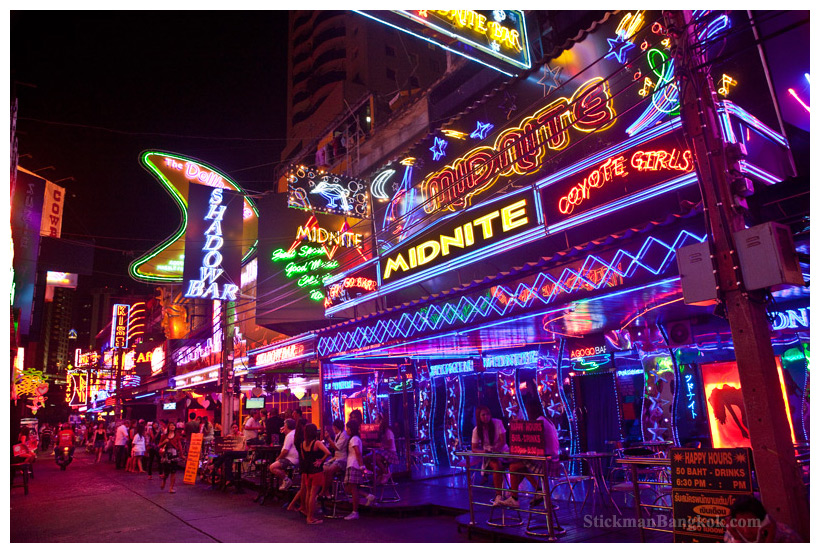
Because a full frame sensor is larger, the part of the sensor where what will be the pixels of the image isn't as cramped and images have a bit more colour and punch to them. I like this picture. Technically it is nothing special but I still like it because of the vibrant colours. This is straight out of the camera with no Photoshop post processing i.e. the colours have not been saturated at all. Images out of a full-frame camera have much more punch to them than what the 20D or other 'crop cameras' produce and the colours look more vibrant and more pleasing. I have heard some refer to this as "the 3D effect". Sure, some smaller digital cameras produce punchy images too but they are invariably heavily processed JPEG images out of the camera that often have an over-processed "digital" i.e. not 'natural' look.
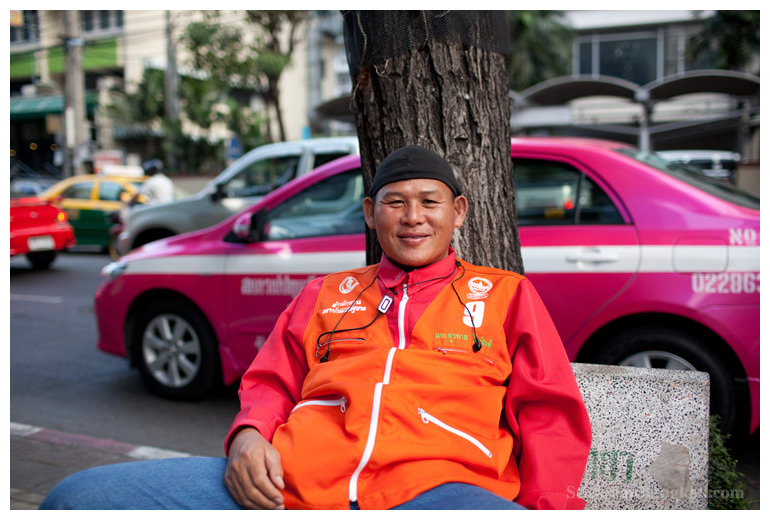
Because the sensor is so large you can have higher ISO settings because the pixels are not crammed as close together as they are in a crop camera or, God forbid, a smaller digital camera.
The image here of a lady from Laos in an Udon Thani bar was taken in pitch darkness. I mean, I really could not see her when I looked through the viewfinder which is a testament to the 5D II's focus system that the image was indeed in focus. This shot was taken at 25,600 ISO, F1.4, 1/30 second. Admittedly much post processing was required to make it viewable and I could only really get it suitable for web size. You probably couldn't get a decent print from this but it does give some idea of just what is possible with the full frame / high ISO combination. This was a fairly extreme example and I cannot imagine shooting in lower light.
So full frame allows for clean or at least somewhat clean high ISO shooting which for someone like me who takes more shots at night than during the day is truly wonderful.
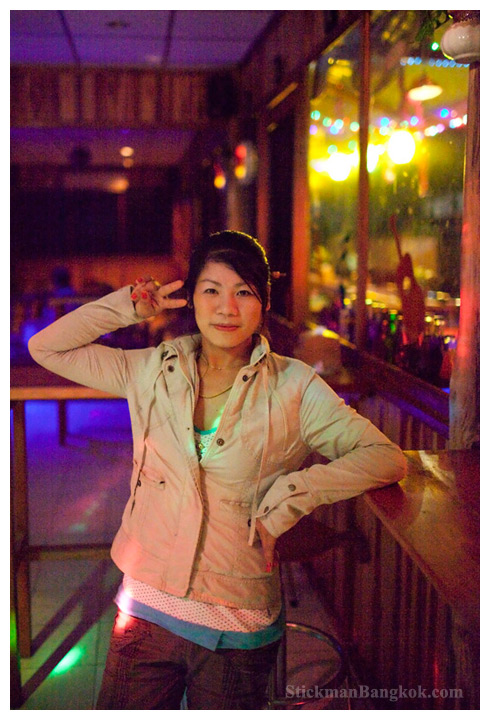
This final photograph would have been difficult to capture on anything but a full-frame camera. Full-frame cameras allow you to use a very narrow depth of field, meaning your subject, or just part of the subject, can be sharp while the rest of the image fades from sharp to blurry to totally out of focus. This allows the photographer to be more creative. Perhaps the biggest drawback with the smaller, cheaper digital cameras is that everything in the image is sharp and there is a very limited capability to control depth of field. This might sound like a good thing but if you wish to be creative, being unable to throw the background out of a focus is a massive drawback. The shot below was taken at ISO 6400 at F1.8 1/30 second. I was very close to the woman yet the noise in the shot is low, the colours are ok (it was much darker than the photo suggests) and the shallow depth of field that full-frame allows works very well. The only part of the entire image that is in focus is the eye of the mother closest to the camera. The rest of the image is a nice dreamy blur which leaves much to the imagination and adds atmosphere to the shot. If the whole image had been in focus – and it would have been with a compact digital camera – the image would have been boring.
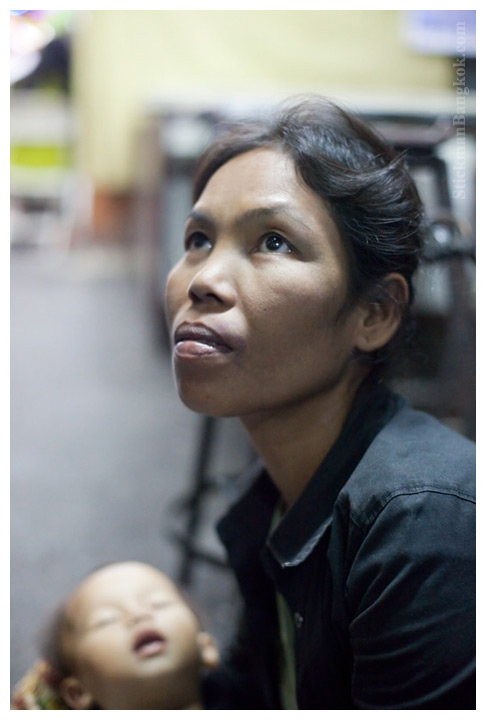
I almost didn't go full-frame. I spoke with BKKSW and mentioned that I may go for a 50D but his answer was short and sweet. A 5D was ideally suited to my type of photography and that is what I should get. I have absolutely no regrets!
Photography News of Interest
PMA 2009 will be taking place in Las Vegas from March 3rd to the 5th. This is a time when many new products will be announced. Though no major DSLR announcements are anticipated, there will be scores of point and shoot compact announcements and probably some new lens announcements for DSLRs. You can keep track of all this by visiting this link.
Canon announces two new tilt-shift lenses for the EOS DSLR systems. Tilt-shift lenses are for advanced users. Canon is updating their 24mm TSE and introducing a brand new 17mm TSE. You can read more about them here.
Have you ever thought that living abroad colors what we see everyday in comparison to what someone seeing everything for the first time may see and feel? I really enjoyed this article where the author discusses just that! You can read it here.
There are two excellent reviews by Thom on Nikon's new DX lenses, the AF-S Nikkor ED 16-85 F/3.5-5.6G IF DX and the AF-S ED 18-105 F/3.5-5.6G IF DX VR. If you have a DX format Nikon camera you’ll want to check out these reviews and see if either of these lenses are right for your needs. The 18-105mm review can be read here and the 16-85mm review can be read here.
The class leading Nikon D3x with its 24mp sensor and great systems finally gets reviewed by DPR. Check out the review here.
Almost all compact point and shoot cameras have CCD based sensors. This is done for cost vs. performance factors but comes with limitations. Ricoh just announced their new CX1 CMOS-sensor zoom compact and it promises to be very interesting. Following on the heels of the Fuji F200EXR announcement with some very innovative and promising features, the CX1 also promises in camera HDR (high dynamic range), a 28-200mm zoom, a fantastic 920,000 dot LCD, and up to 120 frames per second in VGA (640×480) mode.. all in a compact pocket sized body! The new technology on this camera is very interesting. You can read about it here.
Readers' Submissions
I suspect the readers submissions will be a highly anticipated section of this column and I encourage anyone with photographs and travel accounts they'd like to share to please send them to me at: QandA@Bkkimages.com
Hi Steve,
Notice you'll be heading off to Trat later in the week. I'm just back from Khao Kitchakut, Chanburi province, where there is a Buddhist pilgrimage going on. It is only open February/March, so I thought it may be of interest to you.

The turnoff is left on to highway 3249 from Sukhumvit (Hwy 3), about 10 km short of Chantburi town. About 20 km down the road you turn right for another 1 km or so and park at Wat Pluang. They have 4WDs going up the mountain trail in two stages, 100 baht per stage. You then have to walk another 6 km or so to the top. Half of this are hiking trails, so make sure you have decent footwear. Coming down costs 50 baht per stage.

Note that it was extremely crowded when I was there, and that people are coming and going at all hours. I had to wait more than an hour in the queue (at three in the morning!!) before I could get on the first 4WD.

Didn't take many pictures as I was with a merit-making group of friends. Don't think you'll be wanting to lug a lot of equipment, but would think it would be an excellent field trip to test the Fuji F200EXR. Looking at the specs, I already want one! It even has a time-lapse mode.

Cheers
Vincent
Readers' Questions
Steve –
I have a friend in Australia with a Nikon 50mm F1.4. This is an old lens but in great condition as I used it a few times when I used to go to his place. Would this lens be good for portrait photography, taking photos of people?
Charles
Charles –
This is an excellent question. Allow me to briefly answer.
- The older Nikkor lenses are fine lenses. Each model varies as to exactly how good it is, but most of the 50mm F1.4s were fine lenses.
- When you put a 50mm on a APC-S body (your D80) “effectively” makes it a 75mm which is a decent portrait focal length. However, the other characteristics of a lens, color, contrast, sharpness, out of focus character (bokeh) will probably not be the same level of quality as a portrait lens. You could try it and see if you’re happy with the results, but I suspect you’d be much happier with a modern 85mm F1.8 Nikkor.. you can find them used for a few hundred.
- Keep in mind, this might be a manual focus lens. This isn’t a problem if you’re used to manual focusing, or are willing to learn manual focusing techniques.
- For portrait uses, your money would probably be better spent on a purpose designed portrait lens.
I hope this helps.
Steve
Hi Steve,
Thanks for getting back to me. I look forward to seeing my 'Wat's Up' images on In Focus. This is exciting I must say.
I could see that you needed a submission. By the way, it is my pleasure to contribute.
Perhaps my question can be used as a reader's question for In Focus?
I think that many guys with less experience, find 'Photo Shop' both complicated and somewhat confusing to use.
I understand about altering images, so please use your professional eye to select the best 8 or 10 shots and ditch the rest.
I hope all is well with you Steve…
Cheers,
Dave.
Hi Dave –
I just arrived back in Bangkok this evening and have been answering emails.
Yes.. you are right. People ‘think’ they need Photoshop because Photoshop has always been ‘the’ tool for images. The truth is there are many good imaging programs for the “point and shooter”, and most point and shoots come with decent software these days for free if the person bothers to install and check it out.
For free.. Google and check out GIMP at www.gimp.org. It’s a decent, free program. I don’t use it, but I know many who do.
Lightroom is awesome. However, it does require a decent computer because it uses system resources. If you have a halfway modern computer you should be okay to run Lightroom.
Adobe took the most common tools (and then some) photographers used from Photoshop, put them in a slick new photographer friendly interface, and named it Lightroom. The result is a very easy to use photo management and image processing software package which is easy enough for rank beginners, and feature laden enough for professionals. Download their 30 day trial and give it a whirl.
Steve
Hello Steve
I've been reading about Lightroom 2. Is it better than Photoshop CS2? Should I just stay with Photoshop CS2 or use Lightroom 2, or upgrade to Photoshop CS3?
Charles
Hello Charles –
This is a common question and a good one. “Better” depends on what you want to do with your images.
Photoshop has more tools and you can do more things with images than with Lightroom. It’s also triple the price for a basic version.
Lightroom is much better for image management, and most image adjustments photographers are interested in. Lightroom is purpose designed for photographers and using it you can do 99% of the things you’d do in Photoshop, but with a much faster and easier workflow. Lightroom also offers image management features, slideshows, a great print manager, and the ability to upload flash or HTML galleries directly on to your own site. I love Lightroom and it’s what I teach to 99% of my clients. I also teach Photoshop, but most seem very happy with Lightroom. Personally, I use Lightroom for about 98% of my image processing needs, and Photoshop for that 2% where layers and masking are required.
I hope this helps.
Steve
Please submit your questions to QandA@Bkkimages.com All questions will be answered and most will show up in the weekly column.
A Snapshot of Bangkok Images Week in Review
This week we held just a single workshop. We continue to process images from our trip to the national forest and other destinations of last week, and prepare for yet another journey to Trad and Ko Chang next week.
Infocus Blog
Nonsense and Fun!
Have you ever found yourself with your camera in your hands and taking pictures of stupid things just to see what the camera will do and because you’re otherwise bored? I’d guess we all have. Sometimes fiddling around doing fun and nonsensical things can be both entertaining and fun!

The image above was taken at a dinner party recently and was simply a very dirty and cluttered table with a few glasses and candles. I had the point and shoot out taking pictures of friends having a great time, when I saw this scene and decided to just go ahead and snap it to see how it would turn out. To my eyes it’s colorful and a bit interesting. I turned off the automatic flash and was curious how steady I could hold the camera in near darkness.

Several years ago in Siem Reap, Cambodia, I was dead tired after a long day at Angkor and laying on my bed staring at the bucket of ice I’d ordered. I was too tired to actually put the ice in a glass and enjoy it, so I picked up my DSLR with the 85mm F1.2 lens attached which was within reach and decided to try making an interesting composition instead.

Last week while at a party we were fortunate enough to have a classical guitarist as entertainment. He was sitting in total darkness playing softly while all the guests were chatting so I handed my point and shoot to a friend and asked if she’d mind taking a picture of him. I was curious how a point and shoot on fully automatic everything would perform in total darkness. Would the flash be too bright and blow out the highlights, would the flash be powerful enough, would it focus in the darkness, and so on. I could have guessed and I did, but the quality of the image considering the conditions surprised me.

Three years ago at a night market I had my Canon 5d and 24-105mm zoom lens attached and I was sitting there and just got plain bored. I picked it up, held down the shutter, and tried dragging the lights in the scene around the frame. This was a one second exposure and I’ve since sold over ten of these. Do you know who buys them? So far dentist offices! They make the print big, frame it, and stick it on the wall so those in mind numbing pain can be distracted. They always sell in sets of three like images. I’m not sure that’s a testament to my skills, but it is a sale!
Until next time..



